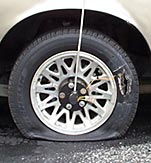The term "blowout" is generally used by drivers to describe a bursting tire accompanied by a rapid loss of air pressure. While one might assume that all blowouts are caused by too much internal pressure bursting a weak spot in the tire, the main reason for them is just the opposite. Most blowouts are caused by too little air pressure allowing the tire to flex beyond its elastic limits until it overheats to the point where the rubber loses its bond to the internal fabric and steel cord reinforcement.
Tire blowouts are usually the result of overloading the vehicle, impact damage (either immediate or delayed depending on severity of the impact), a massive cut that causes rapid air loss, or an unnoticed small puncture that allows the tire to slowly lose air over time until it fails. Blowouts are typically caused by anything that allows air to escape and prevents the tire from supporting the weight of the vehicle.
While tires have become so reliable that "blowouts" are an uncommon occurrence today, their lack of frequency only makes them more surprising and potentially more dangerous when they do occur. Regardless of the cause, what a driver does following a blowout can be the difference between a simple inconvenience or ending up in-the-ditch.
BANG...whoosh...flap...flap...flap...flap! In less than a quarter of a second your drive has gone from cruising to cursing.
Reacting to the surprise of the loud noise and a jerk of the steering wheel, many drivers' first reactions are to lift off of the accelerator, hit the brakes and quickly steer the vehicle to the side of the road. Unfortunately these typical reactions have been shown to be dangerous, and may make it more difficult for the driver to maintain control.
However, preparation begins before the blowout occurs. You will not be ready to respond if you drive with one hand holding a cup of coffee and the other arm resting on the top of the steering wheel. Proper seat and hand position will give you better odds of dealing with any driving situation.
If you experience a blowout, it doesn't make any difference if you are driving a sports car, sporty coupe or sport utility vehicle; the same procedures are appropriate. The driver should step on the accelerator for an instant to preserve vehicle momentum (or at least maintain constant accelerator pedal pressure), and offset the pulling caused by the blown tire by gently counter steering to keep the vehicle in its lane. Once the vehicle has stabilized, the driver can gently slow down and begin to carefully pull over to the side of the road.
Members of the Tire Rack team had the chance to experience tire blowouts at highway speeds at Michelin's Laurens Proving Grounds. Tire after tire was sacrificed as participants were allowed to drive vehicles fitted with tires rigged with explosives attached to their sidewalls (a rear tire on a full-size SUV and a front tire on a full-size sedan). These tires were literally "blown out" with all of the accompanying noises.
While our drivers faced the initial intimidation of knowing they might be challenged to maintain vehicle control, we found that following the recommended procedures allowed us to easily continue in our original lane and gently slow down. Essentially our drivers learned you should continue to drive "through" tire blowouts to maintain vehicle control and worry about determining the cause of the problem later.
Remember: These are techniques, not guarantees. Please drive safely.
Was this post helpful?
768 of 1743 people found this post helpful



